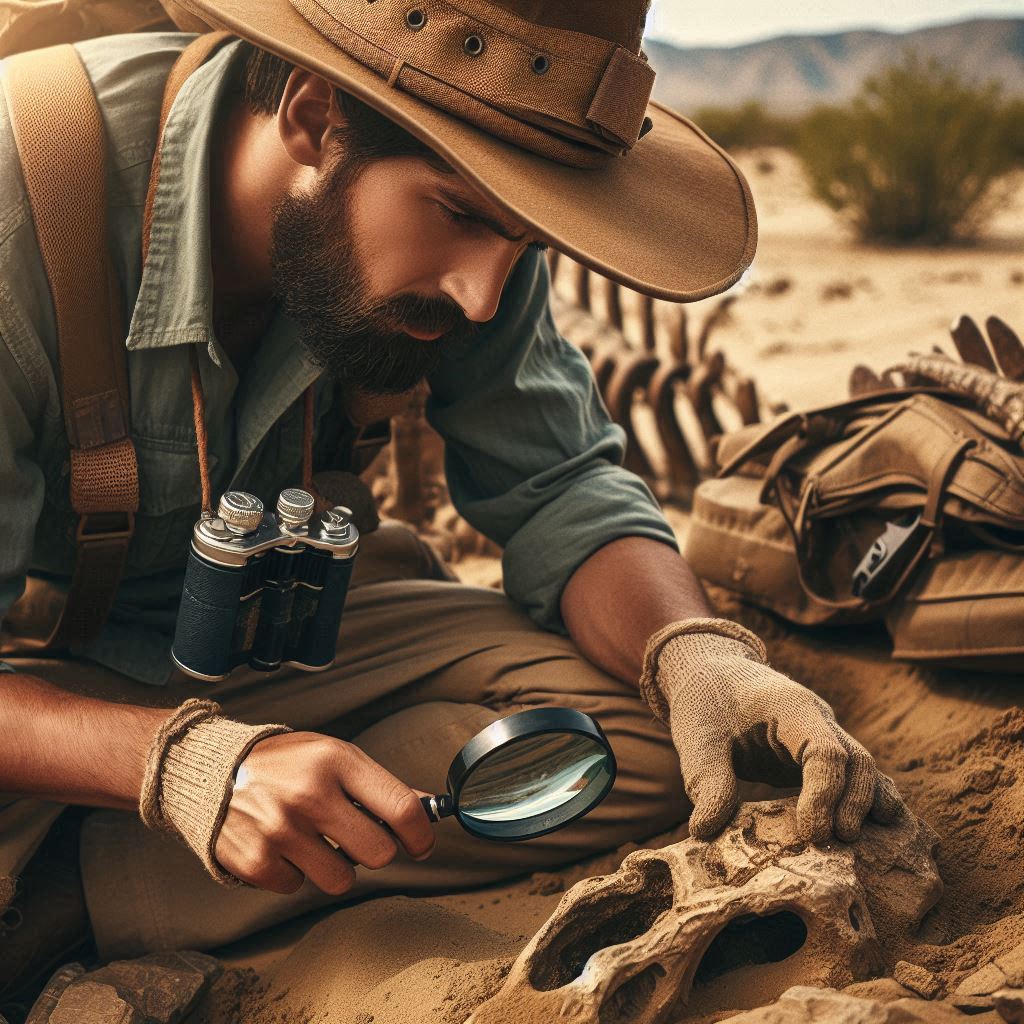Introduction
Publishing research in paleontological journals is crucial for advancing knowledge in the field of paleontology.
It allows scientists to share their findings with peers and the broader community, promoting collaboration and discussion among researchers.
Contributing to these journals helps build a collective understanding of ancient life and ecosystems, paving the way for new discoveries and insights.
Publishing in reputable journals enhances your credibility as a researcher.
It validates your work and establishes you as an authority in your area of expertise.
Furthermore, sharing your research opens doors for collaboration and funding opportunities, as other scientists and institutions recognize your contributions.
Disseminating your research fosters engagement with both the scientific community and the public, raising awareness about paleontology’s relevance to contemporary issues, such as climate change and biodiversity.
This blog post will outline essential steps for successfully publishing research in paleontological journals.
First, we will discuss how to select the right journal for your work.
Understanding a journal’s scope, audience, and impact factor is vital for ensuring your research reaches the right readers.
Next, we will cover the importance of adhering to journal guidelines and formatting requirements.
Each journal has specific submission criteria, and following them closely can enhance your chances of acceptance.
Understand the journal landscape
Research and Identify Reputable Paleontological Journals
Publishing research in paleontological journals is essential for sharing your findings.
First, you must research and identify reputable journals in the field.
Start by exploring databases like Web of Science and Scopus.
These databases list high-impact journals relevant to paleontology and other related disciplines.
Additionally, you can consult the Directory of Open Access Journals (DOAJ) for open-access options.
Look for journals that have a strong reputation among paleontologists.
Well-known journals often have rigorous peer-review processes, ensuring the quality of published research.
Reading through recent issues can give you insight into the types of articles they publish.
Make a list of potential journals that suit your research goals.
Consider the Journal’s Scope, Readership, and Impact Factor
Once you have identified potential journals, consider their scope and readership.
Each journal has specific guidelines regarding the topics they publish.
Understanding the journal’s focus helps you tailor your manuscript to fit their criteria.
For instance, some journals specialize in specific areas of paleontology, like vertebrate or invertebrate studies.
Next, look at the journal’s readership.
Knowing your audience helps you present your research in a way that resonates.
Additionally, consider the impact factor of the journals on your list.
The impact factor indicates how frequently articles from the journal are cited in other research.
Higher impact factors often signify a broader reach and influence in the field.
You can find impact factor information through resources like Journal Citation Reports.
However, remember that impact factor is just one metric.
It should not be the sole determinant of your choice.
A journal with a smaller readership may still provide a suitable platform for your research.
Look for Journals That Align with Your Research Topic and Methodology
Lastly, ensure the journals you consider align with your research topic and methodology.
Each journal has specific aims and objectives that guide their publication decisions.
Review the journal’s author guidelines to see if your manuscript fits.
If your research involves a unique methodology, look for journals that appreciate innovative approaches.
Some journals actively seek studies that employ new techniques in paleontology.
This alignment increases the likelihood of your research being accepted and well-received.
Additionally, consider the journal’s turnaround time for peer review and publication.
Some journals are known for quicker reviews, allowing you to share your findings promptly.
In general, publishing in paleontological journals is a vital step in advancing your career.
Researching and identifying reputable journals lays a strong foundation.
Considering factors like scope, readership, and impact factor ensures you choose wisely.
Aligning your research with the right journal increases your chances of success.
By following these steps, you can effectively contribute to the field of paleontology.
Conduct thorough research
Ensure Your Research Is Novel and Contributes to Existing Knowledge
Publishing in paleontological journals requires original research that adds to existing knowledge.
Before starting your research, review current literature extensively.
Identify gaps in the literature to determine where your work can make a significant impact.
Original findings should address these gaps or provide new insights into known topics.
A clear research question guides your study and ensures its relevance.
Articulating the significance of your research helps reviewers understand its contribution.
Highlight how your findings differ from previous studies and emphasize their importance.
Focus on unique aspects of your research, whether it involves new fossil discoveries or innovative analytical methods.
Once your research is complete, clearly present your findings.
Use clear and concise language to explain your methods and results.
A well-structured manuscript helps convey your message effectively.
Organize your paper into sections, including introduction, methods, results, and discussion.
This structure ensures that reviewers can easily follow your work.
Use Reliable Sources and Cite Them Appropriately
Reliability in sources strengthens your manuscript‘s credibility.
Utilize peer-reviewed articles, books, and reputable online resources to support your research.
Citing these sources appropriately is crucial in academic writing.
Follow the journal’s citation style, whether it is APA, MLA, or another format.
Consistent and accurate citations reflect your attention to detail.
Incorporate citations throughout your manuscript to substantiate your claims.
Use them to support your methodology, results, and discussions.
By referencing previous work, you demonstrate your understanding of the field and build a strong foundation for your research.
Proper citation also helps avoid plagiarism, which can have severe consequences in academia.
Review your references to ensure they are current and relevant.
Older sources may still hold value, but integrating recent studies shows you are aware of current trends.
This approach enhances your manuscript’s overall quality and demonstrates your commitment to rigorous research.
Collaborate with Other Researchers If Needed to Strengthen Your Findings
Collaboration with other researchers can significantly enhance your work.
Partnering with experts in complementary fields brings additional insights and expertise.
This collaboration can lead to innovative approaches and strengthen your findings.
Discussing your research with colleagues can also provide constructive feedback before submission.
Choose collaborators who bring unique skills or perspectives to your research.
Their contributions may help refine your methodology or improve data analysis.
Working in a team allows for a richer discussion of results and interpretations.
These discussions often lead to more robust conclusions and recommendations.
Additionally, co-authoring a paper can broaden your reach and impact.
Collaborators may have established networks and can help promote your research.
They may also offer guidance on navigating the publication process, particularly in selecting suitable journals.
Therefore, successfully publishing in paleontological journals involves ensuring your research is novel and relevant.
Use reliable sources and cite them appropriately to bolster your work’s credibility.
Collaborating with other researchers can further strengthen your findings and enhance the overall quality of your research.
By following these steps, you can improve your chances of publishing in esteemed paleontological journals.
Read: Key Roles and Responsibilities of a Chemist in the US
Prepare your manuscript
Follow the Journal’s Specific Guidelines for Formatting and Submission
Publishing research in paleontological journals requires strict adherence to specific guidelines.
Each journal has unique requirements for formatting and submission.
Before writing, review these guidelines carefully.
Familiarize yourself with the preferred structure, font size, and margin settings.
Each journal typically provides detailed instructions for authors on its website.
Following the journal‘s guidelines enhances your chances of acceptance.
Non-compliance with formatting can lead to immediate rejection.
Pay attention to the submission process as well.
Some journals require online submissions through specific platforms.
Create an account and follow the submission steps outlined by the journal.
Write a Clear and Concise Abstract, Introduction, Methods, Results, and Discussion Sections
A well-organized manuscript is essential for effective communication.
Start with a clear and concise abstract.
This summary should outline the key findings and significance of your research.
Aim for about 250 words, capturing the essence of your study.
The introduction sets the stage for your research.
Provide background information on the topic and highlight its importance.
Clearly state your research question or hypothesis, and explain how your study contributes to the field.
Use the introduction to engage readers and encourage them to continue reading.
Next, present the methods section.
Describe your research design, materials, and procedures in detail.
This transparency allows other researchers to replicate your study.
Use clear language and avoid unnecessary jargon to ensure accessibility.
In the results section, present your findings objectively.
Use clear and direct language to describe your data.
Avoid interpretation at this stage; reserve that for the discussion.
Summarize key findings and highlight significant trends, using bullet points if necessary for clarity.
The discussion section interprets your results and places them in context.
Compare your findings with existing literature and discuss their implications.
Address any limitations and suggest areas for future research.
Ensure this section flows logically from your results.
Include Relevant Figures, Tables, and References
Visual aids enhance understanding and engagement in scientific writing.
Include relevant figures and tables that illustrate key findings.
Ensure all visuals are clearly labeled and referenced in the text.
Properly formatting these elements according to the journal’s guidelines is essential.
Finally, compile a comprehensive reference list.
Include all sources cited in your manuscript, following the specific citation style required by the journal.
This attention to detail reflects your professionalism and respect for the work of others.
In review, successfully publishing research in paleontological journals involves several crucial steps.
Following specific guidelines for formatting and submission is essential.
Write a clear and concise abstract, introduction, methods, results, and discussion sections.
Additionally, include relevant figures, tables, and references to support your findings.
By adhering to these practices, you can enhance your chances of publication and contribute valuable knowledge to the field of paleontology.
Read: Essential Skills and Tools for Modern Chemists in America
Peer review process
Submitting your manuscript for peer review is a crucial step in the process of publishing research in paleontological journals.
Peer review ensures that your work meets the standards of the scientific community and helps improve the quality of your research.
Submit your manuscript for peer review
Once you have completed your research and written your manuscript, the next step is to submit it to a paleontological journal for peer review.
Make sure to carefully follow the journal’s submission guidelines and provide all the necessary information and materials.
When submitting your manuscript, it is important to choose the most appropriate journal for your research.
Consider factors such as the journal’s scope, audience, impact factor, and publication speed.
Selecting the right journal can increase the chances of your work being accepted for publication.
Address any feedback or revisions suggested by reviewers
After submitting your manuscript, it will be sent to experts in the field for evaluation.
These reviewers will assess the quality, validity, and significance of your research and provide feedback on areas for improvement.
It is essential to carefully consider and address all the comments and suggestions provided by the reviewers.
When responding to reviewers’ feedback, be thorough and transparent in your revisions.
Clearly explain how you have addressed each point raised by the reviewers and provide detailed responses to their comments.
This demonstrates your commitment to improving your research and increases the likelihood of your manuscript being accepted for publication.
Revise and improve your manuscript based on peer feedback
After receiving feedback from the reviewers, revise your manuscript to address any issues or shortcomings identified during the peer review process.
Pay close attention to the reviewers’ comments and suggestions and make the necessary changes to improve the quality and clarity of your research.
When revising your manuscript, consider re-analyzing your data, rewriting sections for clarity, and strengthening your arguments based on the feedback received.
It is important to be receptive to constructive criticism and to make revisions that enhance the overall impact and validity of your research.
Read: The Role of Chemists in US Environmental and Sustainability Efforts
Transform Your Career Today
Unlock a personalized career strategy that drives real results. Get tailored advice and a roadmap designed just for you.
Start Now
Copyright and Permissions
When publishing research in paleontological journals, it is essential to adhere to copyright laws and permissions to avoid any legal issues.
Here are some key points to keep in mind
Obtaining Permission for Copyrighted Material
Before including any copyrighted material in your research article, such as images, figures, or excerpts from other publications, you must obtain permission from the copyright holder.
Failure to do so could result in violation of copyright laws and potential legal consequences.
Contact the copyright owner and request permission to use the material in your publication.
Journal Guidelines for Permissions and Attributions
Each paleontological journal may have specific guidelines for obtaining permissions and providing attributions for copyrighted material.
It is crucial to carefully review the instructions for authors provided by the journal or consult with the editorial team to ensure compliance with their policies.
Some journals may require a formal permission letter from the copyright holder, while others may have specific formats for attributions in the manuscript.
Citing Sources and Acknowledgments
When referencing sources in your research article, it is crucial to cite them accurately to give proper credit to the original authors and publications.
Follow the citation style recommended by the journal and provide detailed information about the sources in the references section.
Additionally, it is important to acknowledge any contributions or support received during the research process, such as funding sources, fieldwork assistance, or collaboration with other researchers.
By following these guidelines for copyright and permissions, you can ensure that your research publication in paleontological journals is legally compliant and ethically sound.
Remember to double-check all permissions and attributions before submitting your manuscript to avoid any delays or rejections during the peer-review process.
Read: Day in the Life: An Environmental Scientist‘s Typical Day
Submit your manuscript
Carefully Review Your Manuscript for Any Errors or Inconsistencies
Publishing research in paleontological journals requires careful preparation and attention to detail.
Before submission, thoroughly review your manuscript for errors or inconsistencies.
Start with spelling and grammar; even minor mistakes can detract from your credibility.
Check your figures and tables for accuracy and clarity.
Ensure all references are cited correctly and formatted according to the journal’s guidelines.
Consistent formatting throughout your manuscript enhances readability and professionalism.
In addition to technical accuracy, assess the clarity of your arguments.
Each section should logically flow from one to the next.
Make sure your conclusions are supported by the data presented.
If you have co-authors, involve them in the review process.
They may catch errors you overlooked and provide valuable feedback.
Consider seeking input from a colleague who can offer a fresh perspective on your work.
Their insights may help you refine your arguments and enhance your manuscript.
Write a Compelling Cover Letter and Submit Your Manuscript Through the Journal’s Online Submission System
A compelling cover letter accompanies your manuscript during submission.
This letter introduces your research and highlights its significance within the field of paleontology.
Begin by briefly stating the research question and your main findings.
Clearly articulate why your study is relevant to the journal’s audience.
Mention any previous connections with the journal, such as attending conferences or previous publications.
Follow the journal’s specific submission guidelines carefully.
Each journal may have its own requirements for the cover letter format and manuscript layout.
Adhere to these specifications to avoid delays in the review process.
Most journals require submissions through an online submission system.
Familiarize yourself with the platform to ensure a smooth submission.
Upload all required documents, including the manuscript, cover letter, and supplementary materials, if applicable.
Keep Track of the Status of Your Submission and Be Prepared to Respond to Any Queries from the Editors
After submitting your manuscript, keep track of its status throughout the review process.
Most journals provide an online portal where you can monitor progress.
Familiarize yourself with the typical review timeline for your chosen journal.
Understanding this timeline helps manage your expectations during the waiting period.
Be prepared to respond promptly to any queries from the editors.
They may request additional information or clarification about your research.
Quick, thorough responses demonstrate professionalism and facilitate a smoother review process.
If your manuscript requires revisions, carefully address each comment from the reviewers.
Use their feedback to strengthen your research and improve the manuscript.
Once your manuscript is accepted, be ready for the final steps, including proofreading the galley proofs.
This final review ensures that no errors remain before publication.
Following these steps can significantly increase your chances of successfully publishing your research in paleontological journals.
A well-prepared manuscript, combined with a clear cover letter and timely communication, enhances your credibility as a researcher and contributes to advancing knowledge in paleontology.
Explore Further: Nuclear Science: Historical Breakthroughs
Conclusion
Publishing research in paleontological journals is a vital step for scientists aiming to make an impact in their field.
This process involves several key components, such as selecting the right journal that aligns with your research focus, adhering to the specific submission guidelines, and preparing high-quality manuscripts that clearly communicate your findings.
Conducting thorough literature reviews is essential to understand existing research and to ensure your work adds value to the field.
Engaging in rigorous data analysis and presenting clear, compelling arguments will strengthen your manuscript.
The peer review process plays a crucial role in validating your findings and enhancing the credibility of your research.
Feedback from experienced reviewers can help refine your work, ultimately leading to a stronger publication.
Additionally, revising your manuscript based on constructive criticism demonstrates your commitment to scientific rigor.
I encourage all researchers, especially those in paleontology, to actively pursue publishing opportunities in reputable journals.
Sharing your discoveries not only contributes to the scientific community’s knowledge base but also informs ongoing discussions and debates within the field.
Engaging in this process can lead to valuable collaborations and networking opportunities, further enriching your research experience.
[E-Books for Sale]
The Big Book of 500 High-Paying Jobs in America: Unlock Your Earning Potential
$19.99 • 500 High-Paying Jobs • 330 pages
Explore 500 high-paying jobs in America and learn how to boost your career, earn more, and achieve success!
See All 500 High-Paying Jobs of this E-Book
1001 Professions Without a Degree: High-Paying American Jobs You Can Start Now
$19.99 • 1001 Professions Without a Degree • 174 pages
Discover 1001 high-paying jobs without a degree! Unlock career tips, skills, and success strategies for just $19.99!




